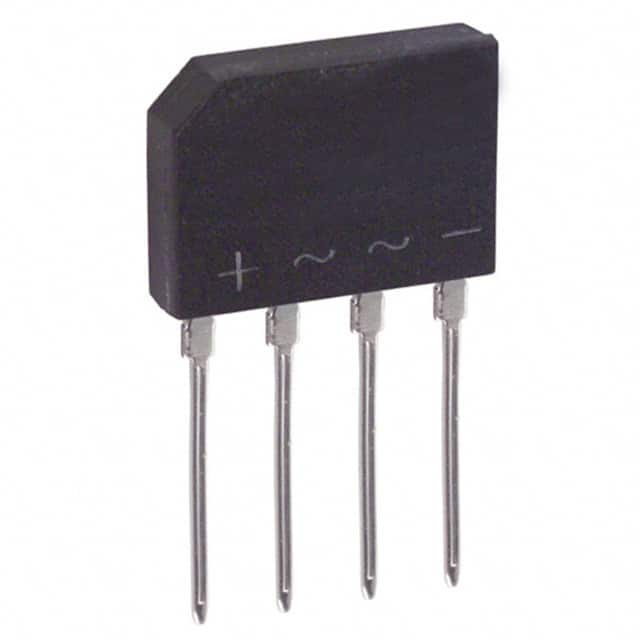KBP06G Diode Bridge Rectifier
Product Overview
The KBP06G diode bridge rectifier belongs to the category of electronic components and is commonly used in power supply circuits to convert alternating current (AC) to direct current (DC). Its characteristics include high efficiency, compact size, and reliable performance. The package typically consists of a molded plastic body with metal leads for easy installation. The essence of the KBP06G lies in its ability to efficiently rectify AC voltage into DC, making it an essential component in various electronic devices. It is commonly available in standard packaging with varying quantities to suit different production needs.
Specifications
- Maximum Average Forward Current: 6A
- Peak Repetitive Reverse Voltage: 600V
- Maximum DC Blocking Voltage: 600V
- Operating Temperature Range: -55°C to +150°C
- Mounting Type: Through Hole
- Package / Case: 4-SIP
Detailed Pin Configuration
The KBP06G diode bridge rectifier typically has four pins arranged in a single in-line package. The pin configuration is as follows: 1. Pin 1: AC Input + 2. Pin 2: AC Input - 3. Pin 3: DC Output + 4. Pin 4: DC Output -
Functional Features
The KBP06G diode bridge rectifier provides full-wave rectification, allowing it to convert the entire input waveform into DC. This feature ensures a smoother output compared to half-wave rectifiers. Additionally, it offers low forward voltage drop and high surge current capability, making it suitable for demanding applications.
Advantages and Disadvantages
Advantages
- Efficient conversion of AC to DC
- Compact size
- Reliable performance
- Low forward voltage drop
Disadvantages
- Higher cost compared to basic diodes
- Limited maximum average forward current
Working Principles
When an AC voltage is applied to the input pins of the KBP06G, the internal diodes conduct during alternate half-cycles, allowing the current to flow through the load in a single direction, resulting in a pulsating DC output. This process effectively converts the AC input into a usable DC output.
Detailed Application Field Plans
The KBP06G diode bridge rectifier finds extensive use in various applications, including: - Power supply units for consumer electronics - Battery chargers - Motor drives - LED lighting systems - Industrial control systems
Detailed and Complete Alternative Models
- DB107: 1A Bridge Rectifier
- GBU606: 6A Glass Passivated Bridge Rectifier
- KBL406: 4A Single-Phase Bridge Rectifier
- W06M: 1.5A Miniature Glass Passivated Single-Phase Bridge Rectifier
In conclusion, the KBP06G diode bridge rectifier is a crucial component in power supply circuits, offering efficient AC to DC conversion with reliable performance. Its compact size and functional features make it suitable for a wide range of applications across various industries.
Word Count: 411
Senaraikan 10 soalan dan jawapan biasa yang berkaitan dengan aplikasi KBP06G dalam penyelesaian teknikal
Sure, here are 10 common questions and answers related to the application of KBP06G in technical solutions:
What is KBP06G?
- KBP06G is a bridge rectifier diode module commonly used in AC to DC conversion applications.
What is the maximum average forward current rating of KBP06G?
- The maximum average forward current rating of KBP06G is typically 6A.
What is the peak repetitive reverse voltage of KBP06G?
- The peak repetitive reverse voltage of KBP06G is typically 600V.
Can KBP06G be used for full-wave rectification?
- Yes, KBP06G can be used for full-wave rectification in AC to DC power supply circuits.
What is the typical junction temperature range for KBP06G?
- The typical junction temperature range for KBP06G is -55°C to +150°C.
Is KBP06G suitable for high-frequency applications?
- No, KBP06G is not typically recommended for high-frequency applications due to its inherent limitations.
What is the package type of KBP06G?
- KBP06G is commonly available in a standard 4-pin inline package.
Can KBP06G be used in automotive electronics applications?
- Yes, KBP06G can be used in certain automotive electronics applications where AC to DC conversion is required.
What are the typical applications of KBP06G?
- Typical applications of KBP06G include power supplies, battery chargers, and general purpose AC to DC conversion circuits.
Does KBP06G require a heat sink for operation?
- It is recommended to use a heat sink with KBP06G when operating at higher currents or in elevated ambient temperatures to ensure proper thermal management.
I hope these answers provide the information you were looking for! If you have any more questions, feel free to ask.


